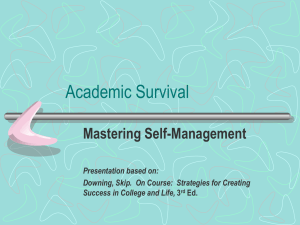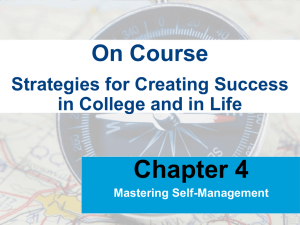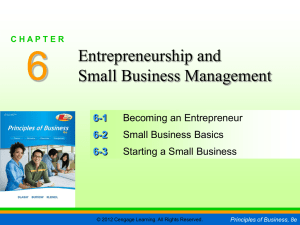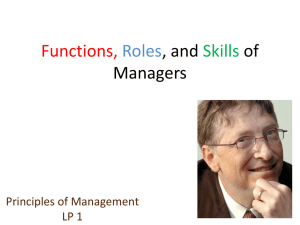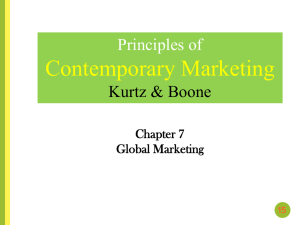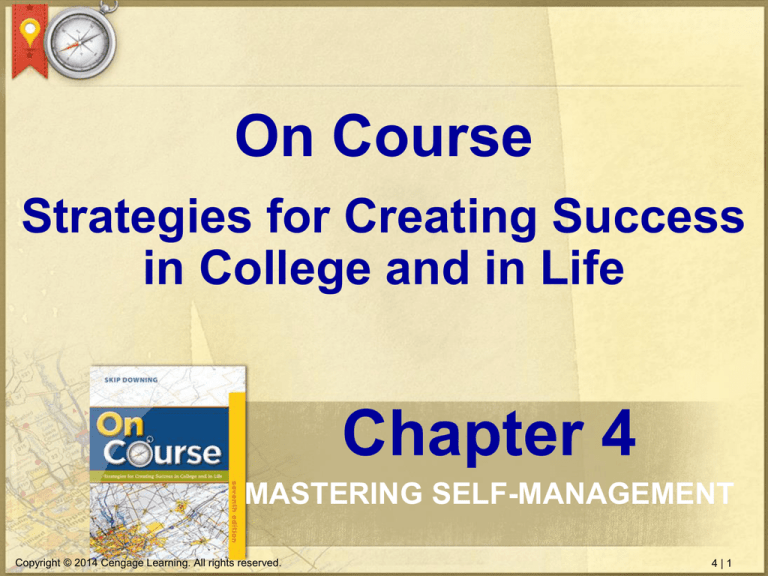
On Course
Strategies for Creating Success
in College and in Life
Chapter 4
MASTERING SELF-MANAGEMENT
Copyright © 2014 Cengage Learning. All rights reserved.
4|1
CASE STUDY IN CRITICAL THINKING:
THE PROCRASTINATORS
What evidence do you see of “Victim
thinking” in the case study?
What self-defeating choices are Tracy and
Ricardo making?
Dive Deeper: Which person's situation,
Ricardo's or Tracy's, is more like yours?
Explain the similarities and identify what you
do to keep up with all of the tasks you need
to complete.
Copyright © 2014 Cengage Learning. All rights reserved.
4|2
MASTERING SELF-MANAGEMENT
• Are you on course to being successful and taking
all of the actions necessary to achieve your
desired outcomes and experiences?
Are you acting on purpose, making choices that keep
you on course to your goals and dreams?
Are you employing self-management tools, regularly
planning and carrying out purposeful actions?
Are you developing self-discipline, showing
commitment, focus and persistence in pursuing your
goals and dreams?
Copyright © 2014 Cengage Learning. All rights reserved.
4|3
CRITICAL THINKING: FOCUS QUESTIONS
ACTING ON PURPOSE
• Have you ever noticed how much highly
successful people accomplish?
• How do they make such effective use of their
time?
llin Sergey
Copyright © 2014 Cengage Learning. All rights reserved.
4|4
Yesterday
• What did you do yesterday? Make a timeline of
your day by listing everything that you did in that
24-hour period.
– Example:
• 5:30 – got up
• 5:30 – 6:00 – Got ready for work (brushed teeth, washed
face, got dressed, etc.)
• 6:00 – 6:30 – Made breakfast for kids, helped kids get
dressed and get school stuff together…
Copyright © 2014 Cengage Learning. All rights reserved.
4|5
HARNESS THE POWER OF QUADRANT II
• Imagine it is the first day of English class. You are
assigned a ten-page essay due in ten weeks. Give
an example of an action for each of the quadrants.
URGENT
Quadrant I
Writing the entire
paper the night
before it is due
IMPORTANT
Quadrant III
NOT
IMPORTANT
Letting friends talk you
into going for pizza
instead of proof
reading your paper
Copyright © 2014 Cengage Learning. All rights reserved.
NOT
URGENT
Quadrant II
Creating a ten-week
plan to complete the
essay step by step
Quadrant IV
Playing video games
for 4 hours each night
instead of writing and
revising your essay
4|6
QUADRANT I ACTIONS
IMPORTANT & URGENT
• Use “Yesterday” and list the appropriate quadrant
for each activity
• Get into groups and list choices you have made
in the past that resulted in your later having to
spend time in Quadrant I.
Example: I watched TV for 2 hours; then I had to stay up late to
finish my math homework when I was exhausted.
Example: I put off going to the doctor for too long; then I had to go
to the emergency room.
• Share your experiences with the rest of the class.
What different choices could you have made?
Copyright © 2014 Cengage Learning. All rights reserved.
4|7
QUADRANT II ACTIONS
IMPORTANT & NOT URGENT
• List Quadrant II actions that you do regularly to be
a success in college.
• Form groups and discuss your lists.
• As a group, choose the 3 best Quadrant II actions
for college students.
Copyright © 2014 Cengage Learning. All rights reserved.
4|8
QUADRANT III
NOT IMPORTANT & URGENT
• As a class, one at a time give an example of
when you chose to do something in Quadrant III
(NOT IMPORTANT and URGENT).
Do the responses have anything in common?
If so, what is the commonality?
Copyright © 2014 Cengage Learning. All rights reserved.
4|9
QUADRANT IV
NOT IMPORTANT & NOT URGENT
• As a class, one at a time give an example of
when you chose to do something in Quadrant IV
(NOT IMPORTANT and NOT URGENT).
Do the responses have anything in common?
If so, what is the commonality?
Copyright © 2014 Cengage Learning. All rights reserved.
4 | 10
CRITICAL THINKING: FOCUS QUESTION
CREATING A LEAK-PROOF
SELF-MANAGEMENT SYSTEM
• How can you devote more
time to creating the
outcomes and
experiences that matter
most to you?
Elnur
Copyright © 2014 Cengage Learning. All rights reserved.
4 | 11
TIME AND CULTURE
• Determine if the following statements are True or
False for you.
Hardly anyone in my family shows up on time
for family gatherings.
I often hear someone in my family talk about
being late for work.
In college, I have been late for classes or
appointments.
• If you answered True for any of these statements,
what are your cultural beliefs about time?
Copyright © 2014 Cengage Learning. All rights reserved.
4 | 12
TIME AND CULTURE
• What is the predominant belief about TIME in
North American higher education?
• If this belief clashes with a student’s own belief
about time, what choices could he or she make to
be successful in college?
Copyright © 2014 Cengage Learning. All rights reserved.
4 | 13
TIME MANAGEMENT TOOLS
What is the time-management tool being described:
A chronological list of important actions
that can be done only at a particular time.
Monthly
Calendar
A list of important actions that need to be
done as soon as possible.
Next
Action List
A list of important actions that need to be
done numerous times to achieve a goal.
Tracking
Forms
A list of actions that you need other
people to do before you can take action.
WaitingFor List
A system to organize a multi-step project.
Copyright © 2014 Cengage Learning. All rights reserved.
Project
Folder
4 | 14
CRITICAL THINKING: FOCUS QUESTIONS
DEVELOPING SELF-DISCIPLINE
• Do you find yourself procrastinating, even on
projects that mean a great deal to you?
• How can you keep taking purposeful actions even
when you don’t feel like it?
Vepar5
Copyright © 2014 Cengage Learning. All rights reserved.
4 | 15
DEVELOPING SELF-DISCIPLINE
What are 3 inner qualities that would strengthen
your self-discipline?
Commitment
Focus
Persistence
Copyright © 2014 Cengage Learning. All rights reserved.
4 | 16
STAYING FOCUSED
• Answer the following questions about this school
term as TRUE or FALSE.
I arrived late to class more than once.
I turned in an assignment that was not my best work.
I daydreamed or side-talked during class.
I missed a class.
I thought about dropping a class and starting over.
I crammed for a test/quiz that was a major grade.
• Get into groups, discuss your answers, and
brainstorm strategies for staying focused.
Copyright © 2014 Cengage Learning. All rights reserved.
4 | 17
SELF-MANAGEMENT AT WORK
• Following are five Quadrant II actions you can
take now to enhance your resume’.
Create a portfolio of your best college work.
Get an internship with a prospective employer.
Engage in volunteer opportunities.
Join clubs/activities that relate to your career.
Get involved with the Student Government at.
your college.
• Rank these five choice in order from the most to
least impressive on your resume’.
Copyright © 2014 Cengage Learning. All rights reserved.
4 | 18
CRITICAL THINKING: FOCUS QUESTIONS
DEVELOP SELF-CONFIDENCE
• In which life roles do you feel most confident?
• In which do you experience self-doubt?
• What can you do to increase your overall selfconfidence?
Copyright © 2014 Cengage Learning. All rights reserved.
4 | 19
RECOMMENDATION LETTERS
• Imagine that you have earned your highest desired
degree and have applied for your dream job.
• Your prospective employer asks for a reference
letter from one of your college professors, so you
ask one of your present instructors to write this
letter for you.
• Pretend you are that instructor and write an honest
and thorough letter of recommendation based on
your actual behaviors and attitudes this semester
in his/her class. Of course give examples.
Copyright © 2014 Cengage Learning. All rights reserved.
4 | 20
RECOMMENDATION LETTERS
• You have 10 minutes to write your letter of
recommendation. Do not put your name on it. I will
collect and read them aloud anonymously.
• As you listen to each letter of recommendation,
decide if the applicant should:
Definitely get an interview
Possibly get an interview
Never get an interview
• Explain your reasons for each decision and
suggest any behaviors the applicant could improve
to get a stronger recommendation.
Copyright © 2014 Cengage Learning. All rights reserved.
4 | 21
QUICK REVIEW
• Match each Quadrant with its description.
Quadrant
I
Urgent & Not Important
Quadrant
II
Not Urgent & Not Important
Quadrant
III
Urgent & Important
Quadrant
IV
Not Urgent & Important
Copyright © 2014 Cengage Learning. All rights reserved.
4 | 22
QUICK REVIEW
• What are 3 inner qualities that will help you
develop strong Self-Discipline?
Commitment
Focus
Persistence
Copyright © 2014 Cengage Learning. All rights reserved.
4 | 23
QUICK REVIEW
Identify each of the self-management tools:
A chronological
MONTHLYlist of
important actions that can be
CALENDAR
done only
at a particular time.
A list
of important
actions
NEXT
ACTIONS
that needLIST
to be done as
soon as possible.
A list of TRACKING
important actions that
need to beFORM
done numerous
times to achieve a goal.
A list of
actions that you need
WAITING-FOR
other peopleLIST
to do before you
can take action.
Copyright © 2014 Cengage Learning. All rights reserved.
A tool PROJECT
to help organize a
multi-step
project.
FOLDER
4 | 24
ORGANIZING STUDY MATERIALS: THE BIG PICTURE
• Three key factors in developing deep and lasting
learning are Prior Learning, Quality of Processing
and Quantity of Processing.
• Which of these three factors are we addressing
most when Organizing Study Materials?
Quality
Of
Processing
Copyright © 2014 Cengage Learning. All rights reserved.
4 SS | 25
GENERAL STRATEGIES
TO IMPROVE STUDYING
• What are some good general study habits that
you can use in learning any subject?
Employ prime learning times.
Tackle challenging subjects first.
Take regular breaks.
Change subjects periodically.
Adopt a growth mind-set.
Copyright © 2014 Cengage Learning. All rights reserved.
4 SS | 26
STRATEGIES TO IMPROVE LEARNING
WHILE ORGANIZING STUDY MATERIALS
• Imagine you have marked and annotated all of
your reading assignments and have taken
detailed notes in class.
How would you condense this information into
effective study materials?
When it is time to organize your condensed
notes, which option would you prefer: a linear
organizer or a graphic organizer? Why?
Copyright © 2014 Cengage Learning. All rights reserved.
4 SS | 27
STRATEGIES TO IMPROVE LEARNING
WHILE ORGANIZING STUDY MATERIALS
Identify each of the following linear organizers:
You copy the textbook’s table of contents onto a blank
page. Then you add important information from your
class notes.
Outline
You summarize all of the information from your
textbook, class notes, handouts, etc., into tightly
focused paragraphs that each explains a key concept.
Concept Blocks
You write a question on one side of an index card and
the answer on the other. After verifying the accuracy
and appropriateness of the questions, you review them
often.
Copyright © 2014 Cengage Learning. All rights reserved.
Flash Cards
4 SS | 28
STRATEGIES TO IMPROVE LEARNING
WHILE ORGANIZING STUDY MATERIALS
Successful Students
Struggling Students
Act on purpose, choosing actions Wait passively or wander from one
that move them on course to
unpurposeful activity to another
their goals and dreams
Employ self-management tools,
regularly planning and carrying
out purposeful actions
Live disorganized, unplanned lives,
What type of information
constantly responding to whims of
the moment.
would be useful
to include in this
Quit or change course when their
comparison
chart?
actions
don’t lead to immediate
Develop self-discipline, showing
commitment, focus, and
persistence in pursing their goals success.
and dreams.
Copyright © 2014 Cengage Learning. All rights reserved.
4 SS | 29
STRATEGIES TO IMPROVE LEARNING
WHILE ORGANIZING STUDY MATERIALS
Match the following graphic organizers to their correct
description.
Create diagrams
and drawings
Especially helpful in developing a deeper understanding
of how items are alike and unalike.
Comparison
charts
Especially helpful for auditory learners. Can pose
questions to yourself, pause, and then offer the answer.
Create an audio
recording
Especially helpful for understanding a subject that
requires classification. Visually depicts the relationships
among levels of information.
Hierarchies
Especially helpful for visual learners. An easy way to
convert words into visual information.
Copyright © 2014 Cengage Learning. All rights reserved.
4 SS | 30
STRATEGIES TO IMPROVE LEARNING
AFTER ORGANIZING STUDY MATERIALS
• After you organize your study materials, what are
some successful strategies you could implement.
Read more on the same subject and add the new
information to your study materials.
Get feedback on your study materials and ask for
suggestions.
If there are concepts you still don’t understand,
seek help (instructors, tutors, etc.) to improve
your study materials.
Copyright © 2014 Cengage Learning. All rights reserved.
4 SS | 31


